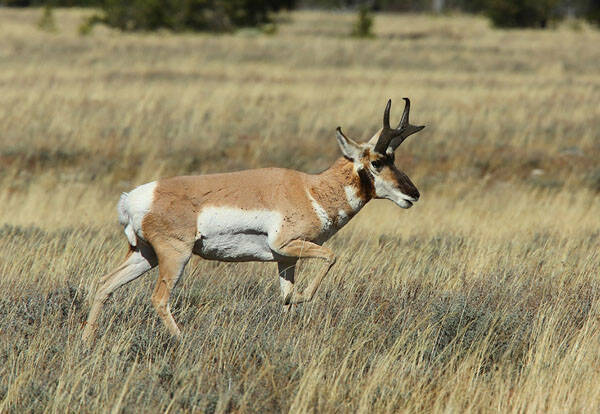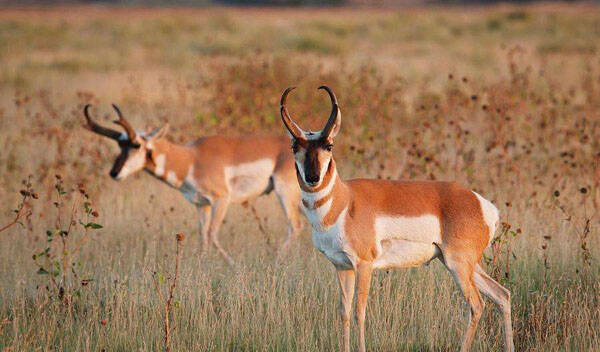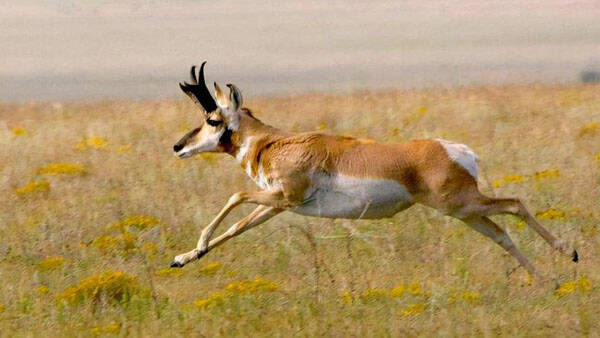Antilocapra americana
IUCN
LCBasic Information
Scientific classification
- name:Antilocapra americana
- Scientific Name:Antilocapra americana,pronghorn,American Antelope
- Outline:Ungulata
- Family:Artiodactyla Antelopedae Antelope
Vital signs
- length:About 1.41 meters
- Weight:47-70kg
- lifetime:10-15years
Feature
Good at running, it is the fastest animal in America
Distribution and Habitat
Pronghorn antelopes are distributed in the open areas of western North America, from southern Canada in the north to northern Mexico in the south.
Pronghorn antelopes feed on grass, shrubs, reeds, etc. Pronghorn antelopes live in wide grasslands and deserts, with terrain elevations ranging from 900 to 2,400 meters.
Appearance
The pronghorn is of medium size, with a body length of 1.41 meters, a tail length of 7.5-10 centimeters, a shoulder height of 87 centimeters, and an adult weight of 47-70 kilograms. Females are smaller than males; both sexes have permanent horns, and the horns of females are smaller and unforked than those of males, while the horns of males are more distinctive, with forked ends, similar to members of the deer family. The horns are bone, without cavities, and without forks. The outside is a hairy sheath, which falls off after the breeding season every year, and a new sheath grows under the old sheath before falling off. The horns are upright, flattened laterally, and the tip is bent backwards. The horns are about 25 centimeters long. The back is reddish brown, with black bristles on the neck, white on the abdomen and buttocks, and black patches on the cheeks and sides of the neck; the hair is downy under the hair, and covered with rough, brittle long hair. The pronghorn sheds in spring
Details
Pronghorn (scientific name: Antilocapra americana) is also known as pronghorn in foreign languages. There are 5 subspecies.

Pronghorn likes to live in groups. In summer, they form small groups of about 50-100 people, and in winter, they gather into large groups of thousands of people. When encountering an enemy, they will alert their companions by standing up the long white hair on their buttocks and snorting. They mark their territory with urine and hoof prints. They feed on cacti, grass, shrub leaves, reeds, etc., but they still have high-crowned teeth suitable for eating grass, and occasionally eat grass. They can use their front feet to dig plants buried by snow. If they can get enough green grass, they can go without drinking water. They are good at swimming. In order to find food and water, they often migrate several times a year. They are alert and have sharp vision, and can see objects several kilometers away. When in danger, the white hair on their buttocks can stand up, which is a special signal to warn their companions.
Pronghorn is the fastest animal in the American continent, the fastest animal in the Western Hemisphere, and the animal on the earth that runs second only to cheetahs (with much stronger endurance than cheetahs). The maximum speed is 86 kilometers per hour. And it has amazing endurance. It can run at a speed of 72 kilometers per hour for up to 11 kilometers, and can jump up to 6 meters at a time. The adaptation of cheetahs to high-speed running is the evolution of a well-elastic spine, while the adaptation of the sturdy body of pronghorns to running lies in slender limbs and enlarged hearts. The slender limbs can jump farther during high-speed running, and pronghorns can jump up to 4.5-6 meters; the enlarged heart is conducive to oxygen metabolism and reduces the oxygen debt generated by exercise. Unlike deer, pronghorns have particularly poor jumping ability and cannot jump over fences, so long-distance fences often hinder the migration of pronghorns.
In early March every year, male pronghorns begin to divide and compete for each other's territories. Males will sniff urine, feces and secretions from glands behind the ears. Usually the division of territory is resolved by staring contests, but sometimes there are chases and fights. During this time, groups of females, usually up to 23 or so, move freely between the territories of different males, while young males eager to mate move around the edges of areas controlled by male territories in search of opportunities.

Pronghorn antelope mate in the summer, from July to October. The sexual maturity period of ewes is 16-17 months, and the gestation period is as long as 252 days. The first litter is one calf, and thereafter, as long as there is sufficient food, there will generally be two calves per litter. The reproduction method of pronghorn antelopes is also quite peculiar. Ewes will release 4-7 eggs during the ovulation period. After the eggs are fertilized, they begin to develop and become slender. The slender fertilized eggs are twisted together in the uterus, entangled and pushed against each other. In the end, most eggs will die of malnutrition due to the reduction of cell membrane area, and the remaining two eggs will eventually develop into embryos. This competition between fertilized eggs in the uterus is still unique to this day. The gestation period is about 8 months, and the first litter usually produces one calf, and thereafter, there will be two calves per litter.
The tacit cooperation between ewes and lambs is also an interesting phenomenon. Generally, ewes will circle around the hiding place of the lambs, and at the same time, they will pretend to be nonchalant to avoid being discovered by coyotes. Because coyotes often wait patiently near suspicious ewes. The frequent observation of ewes at the lambs' hiding places can be used by coyotes to find lambs. On average, ewes return to the lambs to feed them once every 4 hours. Then the lambs change hiding places. The ewes leave quickly. The memory of ewes is amazing. Before leaving, the ewes will turn around and memorize the lambs' new hiding places. This process only takes 3 seconds. In the following hours, the ewes can accurately find the lambs again. Lambs born 4 days ago can run faster than humans.
In order to avoid being discovered by enemies, lambs' ability to adapt to lying still for a long time is still amazing. In the wet and cold weather in March and April in western North America, lying lambs can only maintain their body temperature by generating a lot of body heat. In addition, lying lambs can still remain still until the last moment when danger approaches. Some people have found some lambs whose feet were broken in two by the hooves of passing bison on the grassland where bison and pronghorn coexist. Apparently, the lambs remained motionless when the bison's hooves stepped on them.

The natural enemies of pronghorn are mainly wolves, mountain lions and humans. Coyotes, lynxes and golden eagles pose a threat to lambs. In fact, pronghorns have been co-evolving with cheetahs for 4 million years, competing with each other in running speed, so that they can reach a speed of nearly 100 kilometers per hour. After the mass extinction at the end of the Pleistocene 10,000 years ago wiped out the cheetahs, adult pronghorns basically had no natural enemies. Therefore, lambs became the main target of other animals attacking pronghorns. On the grasslands without cover, the main way for lambs to defend against enemies is to rely on their protective coloration to lie quietly on the ground and not move to avoid being discovered by enemies. Cougars occasionally use some hilly terrain to ambush pronghorns. Wolves sometimes attack pronghorns with their extraordinary endurance and physical strength. But these cannot pose a real threat to pronghorns, except for people with guns.
In the early 19th century, there were tens of millions of pronghorns in the United States. But people used to kill them in large numbers for meat, skins and using their heads as decorations. In the past 100 years, the number has dropped sharply to less than 20,000. Due to strong protection, the number has increased greatly. It is estimated that the number of pronghorns was about 35 million (some say 100 million) when white people arrived in North America, and the population size was second only to the American bison. The number dropped sharply during the reclamation period in the western United States, and in 1924 it was reduced to less than 30,000. Through protection measures, it has recovered to more than 2-3 million (including the United States and Canada). It is one of the most common animals in the wild in the western United States and the main hunting target of the American hunting industry, with an annual hunting quota of 4,000.
The Mexican subspecies of pronghorns (A.a.mexicana) is in poor condition, with only about 1,200 left, and is an endangered protected animal. Other small and protected subspecies include the Peninsular subspecies (A.a.peninsularis) and the Sonoran subspecies (A.a.sonoriensis).
Listed in the IUCN Red List of Threatened Species in 2016 ver 3.1 - Least Concern (LC).
Listed in the CITES Class I protected animals of the Washington Convention.
Listed in Appendix I, Appendix II and Appendix III of the Convention on International Trade in Endangered Species of Wild Fauna and Flora (CITES) 2019 edition.
Protect wild animals and eliminate game.
Maintaining ecological balance is everyone's responsibility!








